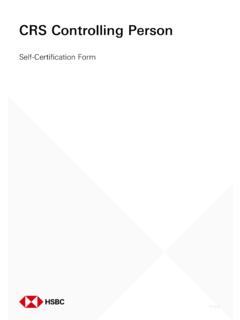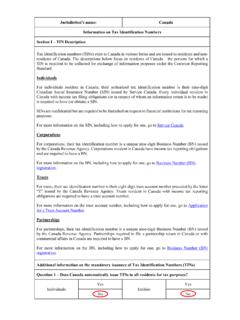Transcription of Implementation Handbook: Standard for Automatic …
1 OECD 2017 1 Standard for Automatic Exchange of Financial Information in Tax MattersIMPLEMENTATION HANDBOOKS econd editionStandard for Automatic Exchange of Financial Information in Tax MattersImplementation HandbookSECOND EDITIONnTablE Of COnTEnTsn2 OECD 2017 Photos credits: OECD 2018 You can copy, download or print OECD content for your own use, and you can include excerpts from OECD publications, databases and multimedia products in your own documents, presentations, blogs, websites and teaching materials, provided that suitable acknowledgment of the source and copyright owner(s) is given. All requests for public or commercial use and translation rights should be submitted to Requests for permission to photocopy portions of this material for public or commercial use shall be addressed directly to the Copyright Clearance Center (CCC) at or the Centre francais d exploitation du droit de copie (CFC) at document, as well as any data and any map included herein, are without prejudice to the status of or sovereignty over any territory, to the delimitation of international frontiers and boundaries and to the name of any territory, city or cite this publication as.
2 OECD (2018), Standard for Automatic Exchange of Financial Information in Tax Matters - Implementation handbook - Second Edition, OECD, OECD 2018 3nTablE Of COnTEnTsnTable of contentsBackground and introduction ..6 Part I: An overview of the steps to implement the Standard ..12 Requirement 1: Translating the reporting and due diligence rules into domestic law, including rules to ensure their effective Implementation ..13 Requirement 2: Selecting a legal basis for the Automatic exchange of information ..41 The legal instrument ..41 Requirement 3: Putting in place IT and administrative infrastructure and Collecting and reporting the information ..462. Receiving the information to send ..483. Transmitting and receiving information ..49 Requirement 4: Protect confidentiality and safeguard data.
3 52 Part II: Overview of the common reporting Standard and due diligence rules ..56An overview of the common reporting Standard ..56 Chapter 1: reporting Financial Institutions ..57 Step 1: Is it an Entity? ..57 Step 2: Is the Entity in the Participating Jurisdiction? ..58 Step 3: Is the Entity a Financial Institution? ..60 Step 4: Is the Entity a Non- reporting Financial Institution? ..60 Chapter 2: Accounts which are Financial Accounts and therefore need to be reviewed ..62 The general rule and the more specific categories ..62 Excluded Accounts ..63standard for Automatic Exchange of financial account Information in Tax MattersImplementationHandbook4 OECD 2018nTablE Of COnTEnTsnChapter 3: Financial Accounts which are Reportable Accounts.
4 65 Reportable Accounts by virtue of the Account Holder ..66 Reportable Accounts by virtue of the Account Holder s Controlling 4: Due diligence procedures ..72 The split between Preexisting Accounts and New Accounts ..73 Chapter : Due Diligence for Preexisting Individual Accounts ..74 Chapter : Due Diligence for New Individual Accounts ..81 Chapter : Due Diligence for Preexisting Entity Accounts ..84 Chapter : Due Diligence for New Entity Accounts ..90 Chapter : Other definitions and general due diligence rules ..96 Chapter 5: The information that gets reported and exchanged ..99 General rules ..103 Chapter 6: Treatment of trusts in the CRS ..104 Chapter : Basic features of a trust ..104 Chapter : Determining whether the trust is a reporting Financial Institution or an NFE.
5 106 Chapter : The treatment of a trust that is a reporting Financial Institution in the CRS ..107 Chapter : The treatment of a trust that is a Passive NFE ..112 Part III: The Standard compared with FATCA Model 1 IGA ..126 Annex I CRS-related Frequently Asked Questions ..146 OECD 2017 5nTablE Of COnTEnTsnBACKGROUND AND INTRODUCTION Standard for Automatic Exchange of financial account Information in Tax MattersImplementationHandbook6 OECD 2018nbaCkgrOunD anD InTrODuCTIOnnThe purpose of the CRS HandbookThe purpose of the CRS handbook is to assist government officials in the Implementation of the Standard for the Automatic Exchange of Financial Account Information in Tax Matters ( Standard ) and to provide a practical overview of the Standard to both the financial sector and the public handbook provides a guide on the necessary steps to take in order to implement the Standard .
6 Against that background, the handbook is drafted in plain language, with a view of making the content of the Standard as accessible as possible to readers. The handbook provides an overview of the legislative, technical and operational issues and a more detailed discussion of the key definitions and procedures contained in the Standard . This second edition of the handbook is intended to be a living document and will be further updated and completed over time. Changes reflected in the second edition of the handbook provide additional and more up-to-date guidance on certain areas related to the effective Implementation of the Standard . This includes revisions to sections pertinent to the legal framework for Implementation of the AEOI, data protection, IT and administrative infrastructures as well as compliance measures.
7 More clarity has been provided in the trust section of the handbook relation to the identification of Controlling Persons. The objective of the handbook is to assist stakeholders in the understanding and Implementation of the Standard and should not be seen as supplementing or expanding on the Standard itself. Cross references to the Standard and its Commentary are therefore included throughout the document. The page numbers refer to the pages in the consolidated second edition of the and Introduction OECD 2018 7nbaCkgrOunD anD InTrODuCTIOnnBackground to the creation of the Standard for Automatic Exchange1. In 2014, the OECD together with G20 countries and in close cooperation with the EU as well as other stakeholders developed the Standard for Automatic Exchange of Financial Account Information in Tax Matters, or the Standard .
8 This was in response to the call of the G20 leaders on international community to facilitate cross-border tax transparency on financial accounts held abroad. The Standard intends to equip tax authorities with an effective tool to tackle offshore tax evasion by providing a greater level of information on their residents wealth held abroad. In order to maximise efficiency and minimise costs the Standard builds on the automated and standardised solutions that jurisdictions previously developed for the purposes of the intergovernmental operationalisation of the US laws commonly known as FATCA. 2. The Standard has now moved from the design to Implementation and application phase with the first exchanges having taken place in September 2017. There are over 100 jurisdictions representing all the major international financial centres that have committed to commence Automatic exchange of information in 2017 or 2018.
9 Within that group there is a small group of jurisdictions that have yet to pass domestic legislation to impose reporting obligations on their financial institutions. Many jurisdictions have also made significant progress in adopting the necessary international legal frameworks enabling cross-border exchanges. 3. The commitment process is monitored by the Global Forum on Transparency and Exchange of Information for Tax Purposes ( Global Forum ) whose role is to ensure timely and effective Implementation of the Standard based on a level playing field. In parallel, the OECD continues its work on the practicalities of the Standard by seeking stakeholder input and clarifying its application through the regular publication of Frequently Asked Questions (FAQs) on the AEOI Portal as well as updates to this handbook .
10 The Automatic information exchange framework4. Figure 1 depicts the Automatic exchange framework for reciprocal information exchange under the Standard . In broad terms, financial Standard for Automatic Exchange of financial account Information in Tax MattersImplementationHandbook8 OECD 2018nbaCkgrOunD anD InTrODuCTIO nninstitutions report information to the tax administration in the jurisdiction in which they are located. The information consists of details of financial assets they hold on behalf of non-resident taxpayers and the income derived therefrom. The tax administrations then exchange that information with the jurisdiction(s) of residence of the This process requires: rules on the collection and reporting of information by financial institutions; IT and administrative capabilities in order to receive and exchange the information; a legal instrument providing for information exchange between the jurisdictions; and measures to ensure the highest standards of confidentiality and data safeguards.















